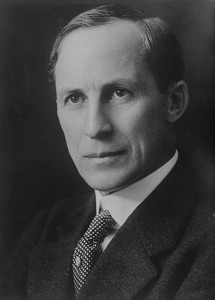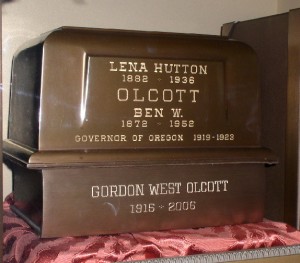Certainly all of Goyne family members deserve their own posting, but I will start with the most famous – Walter James Goyne. Born on May 29, 1897 in Pendleton Oregon, as a baby, he was taken to Skagway in 1898. His father, Francis (Frank) took his whole family to Skagway – wife Hattie, his son Hillary born 1895 Oregon, Ida Evaline born 1888 in Tillamook Oregon, Mabel Florence born 1893 in Tillamook Oregon, Stella Grace born 1896 in Tillamook Oregon, not to mention his Dad, William, born 1838 in Ontario. So, with all the kids, wife and dad in tow, they made it to Skagway to find that Hattie was pregnant again. She bore son Lynn on August 28, 1899 in Skagway. Hattie and the kids moved to Dawson to be with dad in 1900. Another sister, Nugget was born in Dawson in 1901. Dad Frank had been delivering the Dawson Daily News on a 300-mile run in 1904. Although Lynn and his dad Frank stayed in Alaska, Hattie and the kids moved back to Oregon where she divorced Frank and remarried in 1909.
Walter caught the dog mushing bug from his dad and participated in dog sled races elsewhere. He won the Hudon Bay dog sled race in Manitoba due in large part to the harness he was using for his dog team. After the race, the 1920 census has him listed in Fall Lake, Minnesota. Walter was a guest celebrity in Luverne, Minnesota in 1920 when the Palace Theater was showing the movie “Carmen of the Klondike”. Walter drowned when he and dogs went through thin ice on Moose Lake in Manitoba. Below is the grisly obituary from the local newspaper:
| FAMOUS DOG RACER FROZEN IN ICE DOG TEAM STILL HITCHED TO SLED AND THE MAN STILL SITTING UPRIGHTSearching parties have found the body of Walter Goyne, famous American dog derby racer, who was drowned, Nov. 15 when he went through the ice on Moose lake with his dog team. Through the transparent ice the body could be seen in eight feet of water sitting bolt upright on the sled, partly covered by an eiderdown robe. stretched out in front in perfect alignment were the nine racing dogs. The provincial police who investigated the accident, said they believed Goyne was traveling at racing speed toward shore in an effort to escape thin ice, when he plunged through and under heavier ice, where escape was impossible. Of eleven loose dogs that were following Goyne and his racing team, two perished with their master and their bodies were found close to the team. Goyne’s dogs were considered among the best in the north country. and much was expected of the in the 1922 derby.Goyne, Walter (15 Nov 1922)Star Valley Independent |
|
| Here is a further story about the race history:
The first annual race, in 1916 was formulated by Grant Rice, editor of The Pas Herald of the era. In the race of 1920, Walter Goyne, who was born in Ruby, Alaska, made history when he came out of the frozen hinterland of Alaska to compete in the early Le Pas Dog Derby. When Mr. Goyne arrived in The Pas that day many years ago, he discovered that all the local mushers were using an old style toboggan for racing, with their dogs hitched in tandem style. Goyne brought with him the famous Alaskan dog sled with his dogs hitched in the now famous Alaskan hitch, that is, dogs are two abreast with the leader centering the team in front. Northern Manitobans of that era were quite skeptical of Goyne’s sled and “new” hitch and in fact gave him little chance of winning that race of 1920. But when the race was over, and Goyne had won by an easy margin, the skeptics were forced to eat humble pie. Today Goyne’s Alaskan hitch and sled is being used by all famous mushers in Northern Manitoba, the East and the St. Paul Winter Carnival whose dog races date back to 1889. The race of 1920 which Goyne won with ease, will always be remembered as one the Northland’s greatest. Consider the fact that Goyne had a crippled foot which forced him to ride on the sleigh more than his rivals thought best in a long grueling non stop race. You see unlike today’s race, which is broken up into three daily laps, in Goyne’s time it was 140 miles to Cranberry Portage or Flin Flon and back non-stop. Another item Goyne introduced to the North was the parka. Before he came to The Pas, the parka was unheard of. It was while visiting at the home of Mrs. E. W. Bridges that the parka was first introduced as the only type of winter clothing to adequately protect the upper part of the body from the freezing winds of the Northland. Mrs. Bridges took Goyne’s parka and using it as a model she made smaller replicas for her own children, one of whom later made a great name for himself in dog racing in The Pas derbies and those staged in the east. His name, Earl Bridges. Today the parka is a standard part of every northerner’s winter wardrobe. After Goyne’s first big win in 1920, he had one ambition, namely to win the race three times thus receiving the Derby Cup. In 1921, he entered again but was forced out when his 13 year old lead dog failed him. Ironically that was his last race locally. In the fall of 1922 Walter Goyne drowned in Moose Lake. The man who found Goyne’s body was another well know Northern figure, the late Tom Lamb of The Pas. When Goyne’s body arrived at The Pas, The Pas Herald records the incident as follows: “It was a silent procession up Fischer Avenue..and many town dogs fell in with Goyne’s pups. Not a bark or growl was heard, it seemed as if the four footed animals understood the meaning of procession.” |










